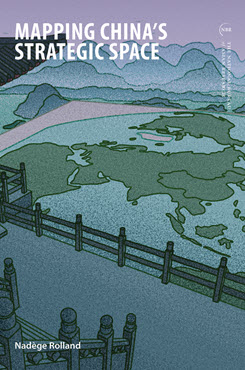Mapping China’s Strategic Space
 The objective of the report “Mapping China’s Strategic Space” by Nadège Rolland (NBR, September 2024) is to better understand what constitutes the imagined space—beyond both China’s national borders and its claimed land and maritime territories—that its leaders consider vital to the pursuit of their national political, economic, and security objectives and to the achievement of China’s rise.
The objective of the report “Mapping China’s Strategic Space” by Nadège Rolland (NBR, September 2024) is to better understand what constitutes the imagined space—beyond both China’s national borders and its claimed land and maritime territories—that its leaders consider vital to the pursuit of their national political, economic, and security objectives and to the achievement of China’s rise.
Foreword
Executive Summary
Introduction: Mapping China’s Strategic Space
Chapter 2: The Return of Geopolitics
Chapter 3: “Positioning” China: Power and Identity
Chapter 4: The Logic and Grammar of Expansion
Chapter 5: Conclusion: A New Map?
Main Argument
Domestic discussions about expansion, initiated before the collapse of the Soviet Union, are still ongoing in the People’s Republic of China (PRC). Heavily influenced by classical geopolitics, these discussions are intimately linked with the country’s self-perception of power and hegemonic aspirations. The need to strive for space is accompanied by a persistent fear of foreign containment. The definition of an expanded geographic sphere of interest and influence first emerged in the form of a quasi-global mental map around 2013, and this conception continues to endure despite China’s current economic slowdown. More recently, this mental map extended to include economic and ideological “space” as well as physical geographies.
Policy Implications
The Mapping China’s Strategic Space project builds on the work that the National Bureau of Asian Research (NBR) has led over the past decade aimed at apprehending Chinese intellectual and political elites’ attempts to define a vision of their country as a great power on the world stage. The project’s main research question stems from an invitation by the U.S. House Foreign Affairs Committee for the principal investigator, Nadège Rolland, to serve as a witness at the March 2021 hearing “America’s Way Forward in the Indo-Pacific” chaired by Representatives Ami Bera and Steve Chabot. To answer the committee’s questions about U.S. responses, it seemed first imperative to understand China’s vision of the region. Immediately apparent was the fact that Beijing does not designate the region as the “Indo-Pacific” (except to describe U.S. strategy) but as China’s “periphery,” which suggests a China-centric conception of the region. This denomination itself, what it entailed, and what it included would be worthy of examining in more detail. And so the Mapping China’s Strategic Space project was born.
This project could not have been possible without a remarkable group of people. Both NBR and the principal investigator would like to sincerely acknowledge the steadfast Carnegie Corporation New York team for its generous sponsorship and commitment to support original policy-relevant research. The project also benefited immensely from the thoughtful guidance and enthusiastic encouragement of the members of the Steering Committee: Jacqueline Deal, Aaron Friedberg, and Christopher Hughes.
The present report is only a fraction of the body of work that was produced over the past two years, with contributions from the following cohort of outstanding international experts: Una Aleksandra Bērziņa-Čerenkova, Bernard D. Cole, Gabriel Collins, Peter Connolly, Kelley Currie, Alexis Dudden, Khyle Eastin, Andrew S. Erickson, Aaron Glasserman, Nadine Godehardt, Jakub Grygiel, Bill Hayton, Timothy R. Heath, April A. Herlevi, Elliot S. Ji, Frank Jüris, Tanvi Madan, Jeffrey Mankoff, Covell Meyskens, James A. Millward, Woodruff Smith, Camilla T.N. Sørensen, Bec Strating, Karen Sutter, and Stephen Wertheim. Our effort to map China’s strategic space would have been incomplete without Louis Martin- Vézian’s ability to translate abstract concepts into exquisitely crafted visual supports and cartographic representations.
Finally, the principal investigator would be remiss not to recognize her exceptional NBR teammates, who have worked tirelessly behind the scenes to help manage, coordinate, organize, research, shoot, brainstorm, edit, and bring to life the project in its finalized form. Thank you Rachel Bernstein, Alayna Bone, Nai-yu Chen, Karolos J. Karnikis, Jessica Keough, Jaymi McNabb, Miles Monaco, Aruna Muthupillai, Jeremy Rausch, Sandra Ward, and Joshua Ziemkowski. Any errors of fact or interpretation that persist in this report are solely the responsibility of its author.